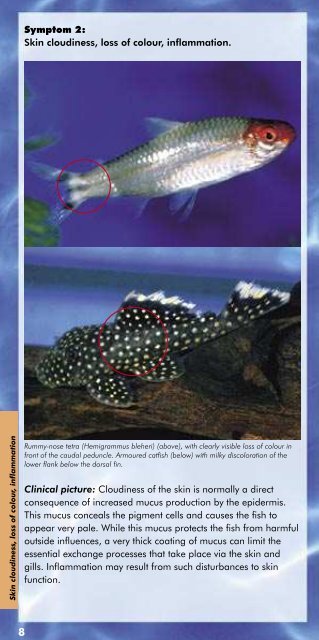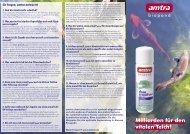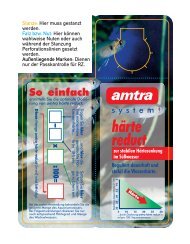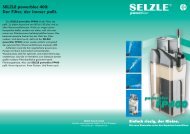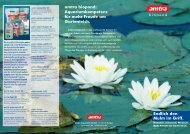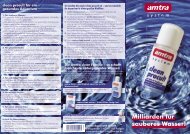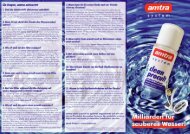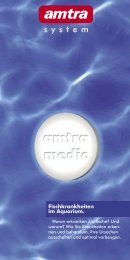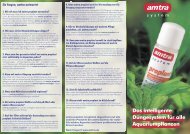Fish diseases in the aquarium. - Amtra
Fish diseases in the aquarium. - Amtra
Fish diseases in the aquarium. - Amtra
Create successful ePaper yourself
Turn your PDF publications into a flip-book with our unique Google optimized e-Paper software.
Sk<strong>in</strong> cloud<strong>in</strong>ess, loss of colour, <strong>in</strong>flammation<br />
Symptom 2:<br />
Sk<strong>in</strong> cloud<strong>in</strong>ess, loss of colour, <strong>in</strong>flammation.<br />
Rummy-nose tetra (Hemigrammus bleheri) (above), with clearly visible loss of colour <strong>in</strong><br />
front of <strong>the</strong> caudal peduncle. Armoured catfish (below) with milky discoloration of <strong>the</strong><br />
lower flank below <strong>the</strong> dorsal f<strong>in</strong>.<br />
Cl<strong>in</strong>ical picture: Cloud<strong>in</strong>ess of <strong>the</strong> sk<strong>in</strong> is normally a direct<br />
consequence of <strong>in</strong>creased mucus production by <strong>the</strong> epidermis.<br />
This mucus conceals <strong>the</strong> pigment cells and causes <strong>the</strong> fish to<br />
appear very pale. While this mucus protects <strong>the</strong> fish from harmful<br />
outside <strong>in</strong>fluences, a very thick coat<strong>in</strong>g of mucus can limit <strong>the</strong><br />
essential exchange processes that take place via <strong>the</strong> sk<strong>in</strong> and<br />
gills. Inflammation may result from such disturbances to sk<strong>in</strong><br />
function.<br />
Cause: The same pathogens that <strong>in</strong>itially attack only <strong>the</strong> f<strong>in</strong>s<br />
(see f<strong>in</strong> damage, pp 6-7), may go on to multiply and parasitise<br />
<strong>the</strong> sk<strong>in</strong>. As well as bacteria, sk<strong>in</strong> flukes, and Costia, unicellular<br />
parasites of <strong>the</strong> ciliate group (eg Chilodonella and Trichod<strong>in</strong>a)<br />
may be <strong>in</strong>volved <strong>in</strong> such changes to <strong>the</strong> sk<strong>in</strong>.<br />
Treatment: Ei<strong>the</strong>r amtra medic 3 or amtra medic 4 should be<br />
used for treatment. In particularly severe cases both medications<br />
can be adm<strong>in</strong>istered simultaneously. In <strong>the</strong> event that <strong>the</strong>re is an<br />
improvement, but not a complete cure, after 4 days, treatment<br />
can be repeated after a partial water change.<br />
Prevention: Pathogenic sk<strong>in</strong> <strong>in</strong>fections are particularly likely to<br />
occur where <strong>the</strong> sk<strong>in</strong> is compromised by unsuitable water conditions.<br />
In order to prevent this, <strong>the</strong> water should be treated with<br />
amtra care (conta<strong>in</strong><strong>in</strong>g Polyvidon) at every water change. Fluctuations<br />
<strong>in</strong> pH, which can also harm <strong>the</strong> sk<strong>in</strong> and are particularly<br />
likely <strong>in</strong> very soft water, should be prevented us<strong>in</strong>g amtra pHconstant<br />
(use amtra kh-aktiv <strong>in</strong> harder water). amtra clean<br />
should be used regularly to prevent <strong>the</strong> build-up of toxic<br />
nitrogenous compounds.<br />
8 9<br />
Sk<strong>in</strong> cloud<strong>in</strong>ess, loss of colour, <strong>in</strong>flammation


